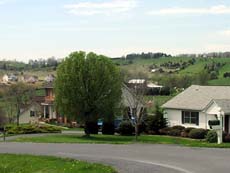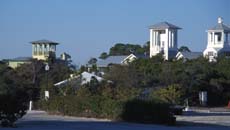Writing about New Urbanism

Street in Middleton Hills, a New Urbanist development in Wisconsin

House in Emerald Hills, a development near Staunton, Virginia, with other developments in the background

Towers in Seaside, Florida
It can be perilous to write about the New Urbanism because the rhetorical weather in its vicinity can be quite violent. Someone who sees virtues in the New Urbanism, but also wants to locate it within wider flows, risks being branded a traitor to true community by those who see New Urbanism as The Way, but also risks condemnation by those those who shun the New Urbanism as Yet Another Deceptive Variety of Sprawl, or as a Nostalgic Idyll that avoids the Tough Truths of Life Today.
The New Urbanism does not deny the need to moderate sprawl -- the New Urbanists make useful proposals about patterns of regional development and urban infill. They insist that while suburban spread can't be stopped, it can be made more dense, which seems to me a correct strategy -- as long as we recognize that the spatial density they are concerned about is only one of the many kinds of density and complexity in places today.
On the other hand, while I respect the spatial strategies of the New Urbanists I find the usual marketing of "old time community" heavy-handed and unrealistic. It needs to be counterbalanced by an acknowledgment of their insertion into larger networks, and enlarged to include other kinds of living groups, some of which might challenge the typical New Urbanist spatial patterns.
I want to (a) to distinguish between the problems of already built suburbs and the problems of new construction (whether infill or greenfield), and (b) to see New Urbanist communities as nodes in a network that permeates them and makes them into new kinds of places.